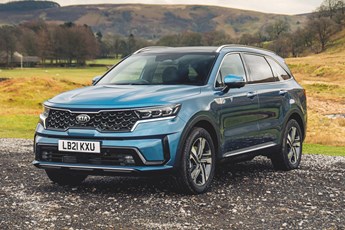
The start point for the best source of fleet information |
First drive: Kia Sorento PHEV
Date: 23 April 2021 | Author: Pete Tullin

|
|
||||||||||||||||
We've already praised the Kia Sorento for its seven-seat versatility, imaginative cabin design and enjoyable driving characteristics. Now that the big, four-wheel-drive SUV is available with a more efficient, plug-in powertrain, we struggle to see how this can do anything other than enhance its desirability.
At £44,940 for the entry-level 2 model, the PHEV is £6,000 more than the HEV version but the addition of that charging lead, a larger 13.8 kWh battery pack and stronger electric motor gives the plug-in 35-mile electric-only driving potential, an official combined-fuel return of 176.6mpg, a CO2 output of 38g/km and a BIK liability of just 11%. This means a 40% taxpayer will save £3,406 per year running a PHEV Sorento rather than the cheaper HEV version.
Save for a minimal four-litre drop in cargo capacity and a rather more telling 93kg hike in kerb weight - batteries are not light - it is amazing just how similar the plug-in feels to its cable-less sibling.
Performance is only slightly upgraded, thanks to the power to weight ratio penalty and without the benefit of a stop-watch, we struggled to identify any tangible go get 'em gains for the PHEV.
Considering the seven-seat family carrying brief, all Sorentos are surprisingly agile, with lots of grip and a surprisingly flat cornering attitude, but given its extra mass, you might expect the plug-in to be a bit more of a handful in bends. This simply isn't the case. At this point you're probably thinking unless Sir Isaac's apple has gone a bit pear-shaped, how can this be?
The answer to this physics conundrum is no more magical than Kia has fitted beefier suspension components to the PHEV and evidence of this can be felt, especially at low speeds, as the PHEV's rear axle's pounds its way over lumps and bumps in the road surface.
Fortunately, as speeds rise, this becomes less of an issue as the Sorento starts to take on a more comfortable, gliding posture.
Obviously, when motivated purely by electricity, the lack of combustion noise from the rather coarse 1.6-litre four-cylinder petrol engine is a welcome refinement gain. Although, its not as significant as you might imagine, as an expressive amount of eerie sounding electric motor whine accompanies the Sorento's momentum.
Although the PHEV gains a more powerful electric motor, the 1.6-litre engine and a slick-shifting six-speed automatic gearbox remain pretty much unchanged. As we hinted earlier, the engine can sound and feels rather agricultural at higher revs, which causes some undesirable vibration to enter the cabin.
Although it is not to the point of irritation, the engine is also reluctant to relinquish its revs when backing off the accelerator pedal and when the wheels stop rolling it maintains a dizzy revving idle, which is part and parcel of the battery charging regime.
Overall though, proceedings are impressively hushed and even at motorway speeds, levels of road and wind noise are commendably low.
Given the additional mass and the potential to carry seven souls, it is as well that the Sorento's brakes are extremely strong, while the pedal feel is reassuringly consistent, something a lot of rival manufacturers of PHEVs would do well to try and emulate.
Undoubtedly, the Sorento's greatest attribute is its ability to carry seven people in comfort and it also makes a decent fist of getting them in and out with a minimal amount of fuss. Pressing a button, the second-row outer seat backrest releases and slides the seats forward in one synchronised movement, so there's no puffing and panting involved. Although the rearmost quarters may not be as airy or quite as accommodating as the latest Toyota Highlander, smaller children will have few complaints and your mates will be more than happy to accept a lift to the pub and back.
There's also a pretty premium feel to the cabin materials and no shortage of glitz, including a sharp reacting infotainment screen, while the main instrumentation changes appearance, depending on which driving mode you're in. Eco, Smart, Sport and various electronically tailored driving traction modes can be selected to cope with varying surface conditions.
Like all Kia's, the plug-in Sorento has a seven-year/100,000-mile warranty, so that should allay any technophobia, and if practicality and affordable running costs are high on your agenda, you'll be hard-pressed to find a better big SUV.
Kia Sorento 2 1.6 T-GDi PHEV 6-speed Auto AWD
P11D: £44,940
Residual value: 44.1%
Depreciation: £25,132
Fuel: £1,824
Service, maintenance and repair: £2,614
Cost per mile: 49.3p
Fuel consumption: 176.6mpg
CO2 (BIK %): 38g/km (11%)
BIK 20/40% a month: £75/£150
Luggage capacity: 175/*809 litres
Engine size/power: 1598cc/4cy turbo-petrol engine 180hp and 67kw electric motor
* Third row seats folded
Verdict |
8/10 |
|||
 |
|
 |
|
|










